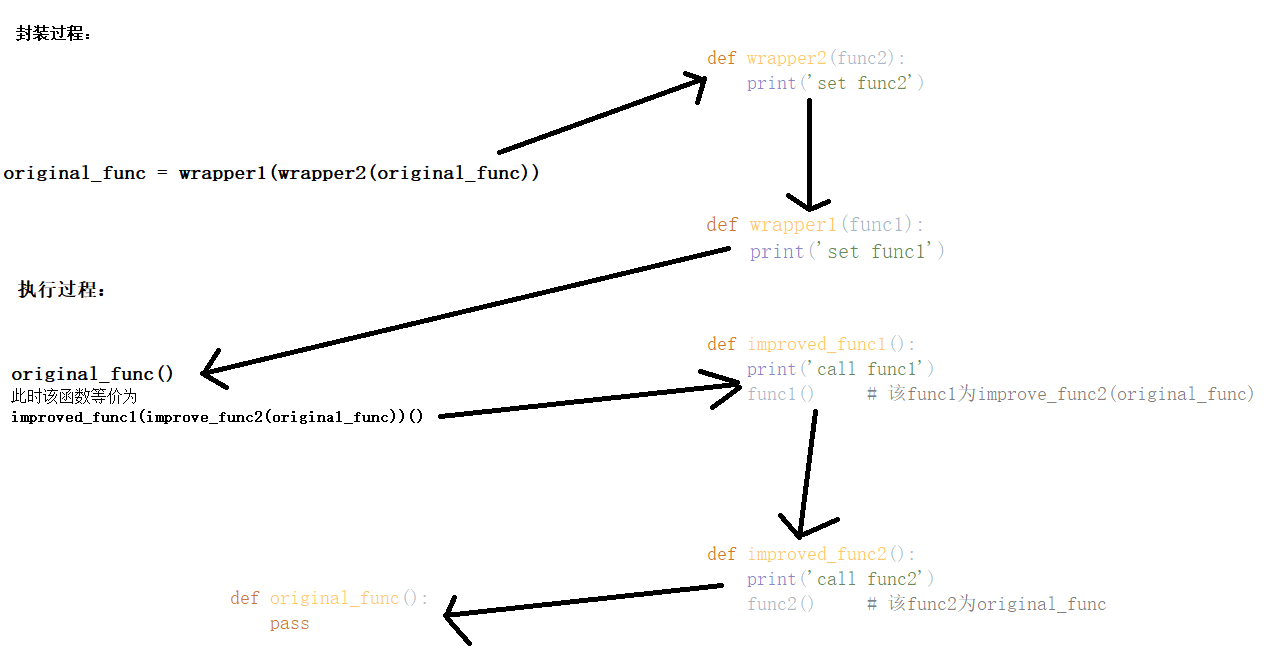Python装饰器
学习视频:
https://www.bilibili.com/video/BV1SZ4y1s7cv?p=1
学习笔记:
装饰器:
装饰器(decorator)的本质:函数闭包(function closure)的语法糖(Syntactic sugar)
代码段1:
求100以内的奇数并计算此过程耗费的时间
import time """ 缺点: 1、函数逻辑(查找奇数)和辅助功能(记录时间)耦合在一起 2、不方便修改,容易引起bug >>>>>>>>能不能将辅助功能从主要功能函数中抽离出来? """ def print_odds(): """ 输出0~100之间所有奇数,并统计函数执行时间 """ start_time = time.perf_counter() # 起始时间 # 查找并输出所有奇数 for i in range(100): if i % 2 == 1: print(i) end_time = time.perf_counter() # 结束时间 print("it takes {} s to find all the olds".format(end_time - start_time)) if __name__ == '__main__': print_odds()
代码段2:
该段代码将代码段1进行了优化,将代码解耦为一个辅助函数和主要函数
import time """ 将辅助功能(记录时间)抽离成一个辅助函数count_time,在辅助函数count_time中调用主要功能函数print_odds. 优点: 解耦,函数职责分离. 缺点: 要通过辅助函数来调用主要功能函数,不方便. >>>>>>>>>我们的目标: 能不能在调用主要功能函数时自动完成对时间的统计? """ def count_time(func): """ 统计某个函数的运行时间 """ start_time = time.perf_counter() # 起始时间 func() # 执行函数 end_time = time.perf_counter() # 结束时间 print("it takes {} s to find all the olds".format(end_time - start_time)) def print_odds(): """ 输出0~100之间所有奇数,并统计函数执行时间 """ for i in range(100): if i % 2 == 1: print(i) if __name__ == '__main__': # print_odds() # 只运行主要函数只会打印出100以内的奇数,无时间统计 count_time(print_odds)
代码段3:
引入函数闭包
什么是函数闭包?
函数式语言(函数是一等公民,可作为变量使用)中的术语
函数闭包:一个函数,其参数和返回值都是函数.
• 用于增强函数功能
• 面向切面编程(AOP)
import time """ 通过闭包增强主要功能函数print_odds,给它增加一个统计时间功能 缺点: 需要显式进行闭包增强 """ def print_odds(): """ 输出0~100之间所有奇数,并统计函数执行时间 """ for i in range(100): if i % 2 == 1: print(i) # 闭包函数本质上是一个函数 # 闭包函数的传入参数和返回值也都是函数 # 闭包函数的返回值函数是对传入函数进行增强后的结果 def count_time_wrapper(func): """ 闭包,用于增强函数func: 给函数func增加统计时间的功能 """ def improved_func(): start_time = time.perf_counter() # 起始时间 func() # 执行函数 end_time = time.perf_counter() # 结束时间 print("it takes {} s to find all the olds".format(end_time - start_time)) return improved_func if __name__ == '__main__': # 调用count_time_wrapper增强函数 print_odds = count_time_wrapper(print_odds) print_odds()# improved
代码段2和代码段3的区别:
代码段2是通过调用辅助函数来实现主功能
代码段3是通过调用主要函数来实现辅助功能
代码段4:
引入装饰器
什么是语法糖? 指计算机语言中添加的某种语法,这种语法对语言的功能没有影响,但是更方便程序员使用。 语法糖没有增加新功能,只是一种更方便的写法 语法糖可以完全等价地转换为原本非语法糖的代码
装饰器在第一次调用被装饰函数时进行增强

解释:
装饰器在第一次调用被装饰函数时进行增强
• 增强时机?在第一次调用之前
• 增强次数?只增强一次
import time """ 通过装饰器进行函数增强,只是一种语法糖,本质上跟断码段3完全一致. """ def count_time_wrapper(func): """ 闭包,用于增强函数func: 给函数func增加统计时间的功能 """ def improved_func(): start_time = time.perf_counter() # 起始时间 func() # 执行函数 end_time = time.perf_counter() # 结束时间 print( "it takes {} s to find all the olds".format(end_time - start_time)) return improved_func @count_time_wrapper def print_odds(): """ 输出0~100之间所有奇数,并统计函数执行时间 """ for i in range(100): if i % 2 == 1: print(i) if __name__ == '__main__': # 装饰器等价于在第一次调用函数时执行以下语句: # print_odds = count_time_wrapper(print_odds) print_odds()
装饰器的多种情况:
1、主函数无参数列表和返回值
即代码段4
2、主函数有返回值
代码段5:
import time def count_time_wrapper(func): """ 闭包,用于增强函数func: 给函数func增加统计时间的功能 """ def improved_func(): start_time = time.perf_counter() # 起始时间 func() # 执行函数 end_time = time.perf_counter() # 结束时间 print("it takes {} s to find all the olds".format(end_time - start_time)) return improved_func def count_odds(): """ 输出0~lim之间所有奇数,并统计函数执行时间 """ cnt = 0 for i in range(100): if i % 2 == 1: cnt+=1 return cnt # 对于含有返回值的函数,调用闭包增强后,不能成功返回,但是成功增强了辅助功能 if __name__ == '__main__': print('增强前') print(count_odds()) # 装饰前函数能正常返回 print('----------------------') print('增强后') count_odds = count_time_wrapper(count_odds) print(count_odds()) # 装饰后函数不能正常返回
结果:
增强前 50 ---------------------- 增强后 it takes 9.200000000000874e-06 s to find all the olds None
所以对于有返回值的主函数,我们需要在闭包函数中将返回值再次返回出来,将代码段5进行修改:
代码段6:
import time def count_time_wrapper(func): """ 闭包,用于增强函数func: 给函数func增加统计时间的功能 """ def improved_func(): start_time = time.perf_counter() # 起始时间 result = func() # 执行函数 end_time = time.perf_counter() # 结束时间 print("it takes {} s to find all the olds".format(end_time - start_time)) return result return improved_func def count_odds(): """ 输出0~lim之间所有奇数,并统计函数执行时间 """ cnt = 0 for i in range(100): if i % 2 == 1: cnt+=1 return cnt # 对于含有返回值的函数,调用闭包增强后,不能成功返回,但是成功增强了辅助功能 if __name__ == '__main__': print('增强前') print(count_odds()) # 装饰前函数能正常返回 print('----------------------') print('增强后') count_odds = count_time_wrapper(count_odds) print(count_odds()) # 装饰后函数能正常返回
结果:
增强前 50 ---------------------- 增强后 it takes 9.100000000001468e-06 s to find all the olds 50
3、主函数有参数列表:在代码段6的主函数加上一个参数,如代码段7所示:
import time def count_time_wrapper(func): """ 闭包,用于增强函数func: 给函数func增加统计时间的功能 """ def improved_func(): start_time = time.perf_counter() # 起始时间 result = func() # 执行函数 end_time = time.perf_counter() # 结束时间 print("it takes {} s to find all the olds".format(end_time - start_time)) return result return improved_func def count_odds(lim=100): """ 输出0~lim之间所有奇数,并统计函数执行时间 """ cnt = 0 for i in range(lim): if i % 2 == 1: cnt+=1 return cnt # 对于含有参数的函数,调用闭包增强后,不能成功接收参数
if __name__ == '__main__': print('增强前') print(count_odds(lim=1000)) # 装饰前函数能正常运行 print('----------------------') print('增强后') count_odds = count_time_wrapper(count_odds) print(count_odds(lim=1000)) # 装饰后函数不能正常运行
运行结果:运行失败,提示缺少参数
TypeError: improved_func() got an unexpected keyword argument 'lim'
增强前 500 ---------------------- 增强后
将代码段7进行修改:
import time def count_time_wrapper(func): """ 闭包,用于增强函数func: 给函数func增加统计时间的功能 """ def improved_func(*args, **kwargs): # 增强函数应该把接收到的所有参数传给原函数 start_time = time.perf_counter() # 起始时间 ret = func(*args, **kwargs) # 执行函数 end_time = time.perf_counter() # 结束时间 print("it takes {} s to find all the olds".format(end_time - start_time)) return ret # 增强函数的返回值应该是原函数的返回值 return improved_func def count_odds(lim=100): """ 输出0~100之间所有奇数,并统计函数执行时间 """ cnt = 0 for i in range(lim): if i % 2 == 1: cnt += 1 return cnt if __name__ == '__main__': print('增强前') print(count_odds(lim=100000)) # 装饰前函数能正常返回,能接收参数 print('-----------') print('增强后') count_odds = count_time_wrapper(count_odds) print(count_odds(lim=100000)) # 装饰后函数能正常返回,能接收参数
运行结果:
增强前 50000 ----------- 增强后 it takes 0.004931700000000004 s to find all the olds 50000
一个保留了参数列表和返回值的函数闭包写法:

关于装饰器的面试题:
1、多个装饰器,求输出
题目:
def wrapper1(func1): print('set func1') # 在wrapper1装饰函数时输出 def improved_func1(): print('call func1') # 在wrapper1装饰过的函数被调用时输出 func1() return improved_func1 def wrapper2(func2): print('set func2') # 在wrapper2装饰函数时被输出 def improved_func2(): print('call func2') # 在wrapper2装饰过的函数被调用时输出 func2() return improved_func2 @wrapper1 @wrapper2 def original_func(): pass if __name__ == '__main__': original_func() print('-----') original_func()
结果:
set func2 set func1 call func1 call func2 ----- call func1 call func2
详细解释:
def wrapper1(func1): print('set func1') def improved_func1(): print('call func1') func1() # 封装了improve_func2(original_func) return improved_func1 def wrapper2(func2): print('set func2') def improved_func2(): print('call func2') func2() # 封装了original_func return improved_func2 # @wrapper1 # @wrapper2 def original_func(): pass if __name__ == '__main__': # 两个装饰器等价形式1: # original_func = wrapper1(wrapper2(original_func)) # 两个装饰器等价形式2: print(original_func.__name__) # 未进行封装前:original_func = original_func() original_func = wrapper2(original_func) print(original_func.__name__) # original_func = improved_func2(封装original_func)() original_func = wrapper1(original_func) print(original_func.__name__) # original_func = improved_func1(improved_func2(封装original_func))() # 此时的original_func = improved_func1(improve_func2(original_func)) original_func() print('-----') original_func()
1、流程:
func = warp1(warp2(func))
封装顺序:warp2--warp1
封装流程:warp1封装的内容是imporved2, imporved2是func经warp2封装过的一级封装
调用顺序:imporve1---imporve2
2、为什么第一次执行original_func()和第二次执行original_func()输出不一样?
装饰器在第一次调用被装饰函数时进行增强
• 增强时机?在第一次调用之前
• 增强次数?只增强一次
2、如何创建带参数的装饰器
在装饰器中填写info字段




 浙公网安备 33010602011771号
浙公网安备 33010602011771号